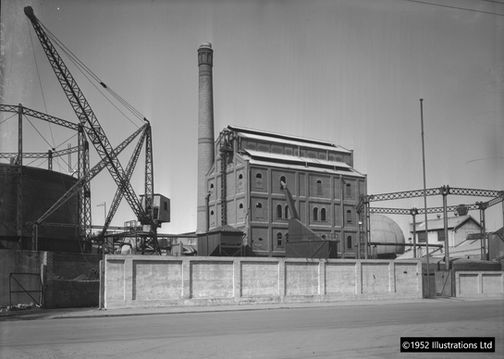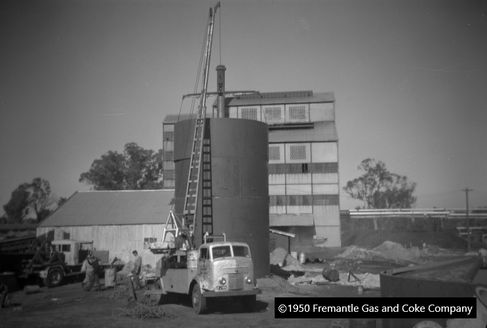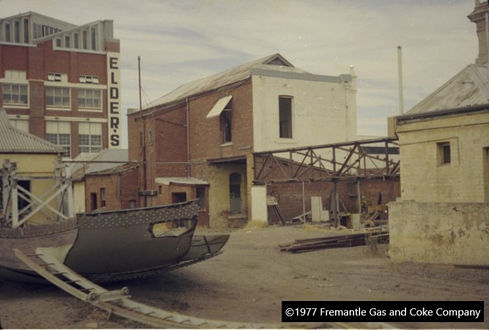Fremantle Gas & Coke
Long before Fremantle was connected to natural gas or electricity, the town was lit up and heated with coal gas, made right in the middle of town. The company behind it was the Fremantle Gas and Coke Company and its story begins with an engineer named Robert S. Newbold.
Robert Newbold
Robert Newbold, formerly with the Melbourne Gas Company, was sent to Fremantle in 1883 to establish a gasworks on Cantonment Street. It was known as the Fremantle Gas Company, although some sources refer to it as Needle’s Gas, owned by A.G. Rosser.
His initial task was to provide gas for the town’s streetlights but as the network expanded, the supply was extended to homes for cooking and heating. At the time, Fremantle had no public lighting and relied on candles, oil lamps, and kerosene. Within two years, the gasworks had laid more than two kilometres of mains. The arrival of electric lighting in 1904, switched on in an instant, meant there was no longer a need for someone to walk the streets each evening lighting the gas lamps (1).
Although it's hard to find out what kind of training Newbold had, he clearly had the skills and experience needed to design and operate a functional gas plant. He also played a part in the community, serving on the Fremantle Town Council and leading the local volunteer fire brigade.
Raising the Capital
The Fremantle Gas and Coke Company Limited, established in 1885, proposed taking over the Fremantle Gas Company. It was a limited liability company, which allowed people to buy shares and invest, without risking their personal assets beyond what they invested.
A prospectus (an investment invitation) was issued on 29 July 1885 and the first directors met at the Emerald Isle Hotel in Fremantle to get things moving. The company grew through public share subscriptions, people investing money in exchange for a stake in the company.
By 1929, the company’s growth prompted the directors to double the company’s capital, from £30,000 to £60,000, to fund upgrades to the aging plant and to expand its services.

Gas and Coke
As well as producing gas, the company also manufactured coke, a solid fuel made during the gas-making process. The coal was originally shipped in from Newcastle (NSW) and, in later years, brought by rail from the Collie Coalfields. It was heated in large ovens to release gas but what remained was coke, which was sold as a clean-burning fuel for stoves, blacksmithing and industrial boilers.
The gas was stored in large round tanks known as gasometers, which became landmarks in Fremantle until they were removed in the 1970s.
Location
The main gasworks were on Cantonment Street, with the company’s showroom and offices at No. 8 Cantonment Street. In 1953, a new modern showroom building was constructed, where it still stands today. Located behind, was the old Wesley Manse building which was constructed in 1893 and later used by the company as a workshop. Both buildings are heritage-listed and remain in use today, restored and repurposed for commercial use.

A new gas plant was built in Spearwood on a 43-acre site at a cost of £250,000. The facility featured an 80-foot chimney stack, a retort house (the gasworks building where coal was heated in sealed vessel without air, producing coal gas, tar and coke), a 500,000 cubic feet gas holder (also known as a gasometer, a large cylindrical storage tank that holds gas after production), a tank stand and its own water supply. At the time, it was considered one of the most modern gasworks in Australia, supplying gas to the Fremantle district, including Melville, Cottesloe, Peppermint Grove and part of Claremont.
The gas plant operated in Spearwood until its reported relocation to O’Connor in 1976, though no further details about the O’Connor site have been found. The Spearwood site today comprises a housing estate between Angus Avenue and Leonard Way.
Changing Times
The Fremantle Gas and Coke Company remained a major local utility provider for more than 100 years, serving thousands of homes in the Fremantle area but by the 1980s, natural gas had replaced coal gas and the company was no longer needed in its original form.
In 1986, the State Energy Commission of Western Australia (SECWA) purchased the property for $39.7 million, giving its previous owners, Western Continental Corporation a $15 million profit. The transaction later came under scrutiny during the WA Inc Royal Commission, which examined questionable government dealings of the era.
References
(1) Freo: A Portrait of the Port City, Stan Gervas (1996). Gervas Books. p.38

.png)




















